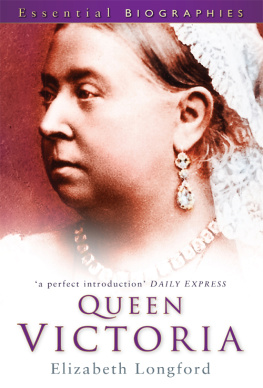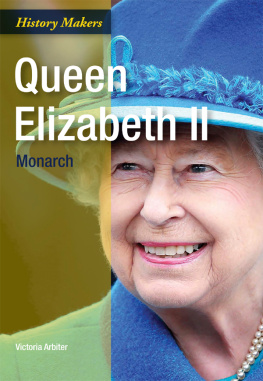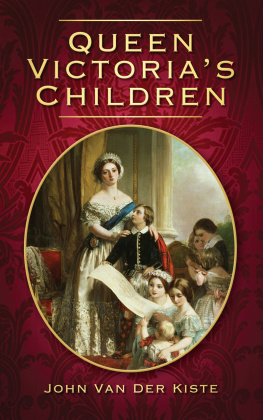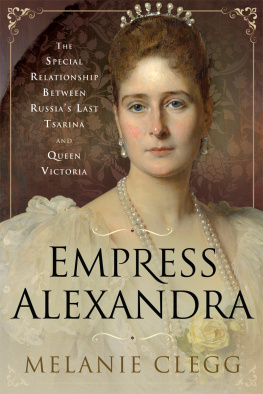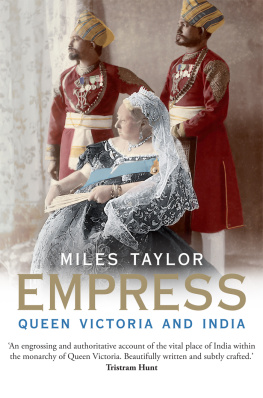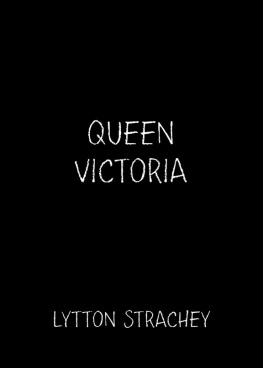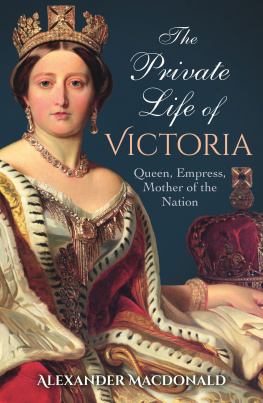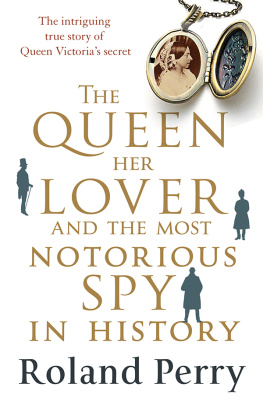Queen Victoria
E LIZABETH L ONGFORD
Series Editor C.S. Nicholls
Highly readable brief lives of those who have played a significant part in history, and whose contributions still influence contemporary culture.
First published in 1999
This edition first published in 2009
The History Press
The Mill, Brimscombe Port
Stroud, Gloucestershire, GL 5 2 QG
www.thehistorypress.co.uk
This ebook edition first published in 2011
All rights reserved
The Estate of Elizabeth Longford, 2005, 2009, 2011
The right of Elizabeth Longford, to be identified as the Author of this work has been asserted in accordance with the Copyrights, Designs and Patents Act 1988.
This ebook is copyright material and must not be copied, reproduced, transferred, distributed, leased, licensed or publicly performed or used in any way except as specifically permitted in writing by the publishers, as allowed under the terms and conditions under which it was purchased or as strictly permitted by applicable copyright law. Any unauthorised distribution or use of this text may be a direct infringement of the authors and publishers rights, and those responsible may be liable in law accordingly.
EPUB ISBN 978 0 7524 6913 3
MOBI ISBN 978 0 7524 6914 0
Original typesetting by The History Press
C ONTENTS
For Frank
A CKNOWLEDGEMENTS
I would like to thank Lady de Bellaigne and all her staff at the Royal Archives for permission to use the Letters and Journals of Queen Victoria, and other material in the Archives. I am particularly grateful for permission to publish for the first time the letter written by Queen Victoria to her doctor Sir Charles Locock, on the controversial subject of her daughters nursing their babies. I must also thank my agent Mike Shaw, my friend John Murray, my daughter Antonia Fraser and my granddaughter Flora Soros.
C HRONOLOGY
| 1819 | 24 May. Alexandrina Victoria born, Kensington Palace. |
| 1820 | 23 January. Victorias father, Edward Augustus, fourth son of George III, dies. |
| 29 January. George III dies. George IV ascends the throne. |
| 1830 | George IV dies. William IV ascends throne. |
| 1837 | 24 May. Victorias eighteenth birthday. |
| 1837 | 20 June. William IV dies. Victoria ascends throne at eighteen. |
| 1838 | 28 June. Victoria crowned, Westminster Abbey. |
| 1839 | 15 October. Victoria proposes to Albert. |
| 1840 | 10 February. Marries Albert, Chapel Royal. |
| 1840 | Victoria, Princess Royal born. |
| 1841 | Albert, Prince of Wales born. |
| 1843 | Alice born. |
| 1844 | Alfred born. |
| 1846 | Helena born. |
| 1848 | Louise born. |
| Year of Revolutions, King Louis-Phillipe of France escapes to England. |
| 1850 | Arthur born. |
| 1851 | Crystal Palace built, Great Exhibition opened. |
| 1853 | Leopold born. |
| 18546 | Crimean War. |
| 1855 | April. State visit by French Imperial couple, Napoleon III and Eugnie. |
| 1857 | Beatrice born. |
| Albert given title of Prince Consort. |
| 1858 | Princess Royal marries Prince of Prussia. |
| 1861 | 14 December. Albert dies. |
| 18619 | Victorias seclusion. |
| 1863 | Prince of Wales marries Denmarks Princess Alexandra. Baron Stockmar dies. |
| 1864 | Prussia, under Bismarck, invades the Duchies. |
| 1865 | Lord Palmerston dies. |
| Victorias uncle Leopold, King of Belgians, dies. |
| John Brown brought south on advice of Dr Jenner to entice the Queen into fresh air. |
| 1868 | January. Disraeli becomes Prime Minister. |
| 1868 | November. Disraeli defeated by Gladstone. |
| Leaves from the Journal of our life in the Highlands 184861 published. |
| 1869 | Victoria fifty years old. |
| 1870 | Franco-Prussian War, Napoleon III defeated and forced to abdicate. |
| Royalty Question arises in England and there are calls for Victorias abdication. |
| 1872 | 27 February. Victoria emerges for first official public appearance to attend thanksgiving service held at St Pauls for her heirs recovery from typhoid. |
| 1874 | February. Disraeli in power again. |
| 1876 | May Day. Queen Victoria declared Queen-Empress of India, Britain and Ireland. |
| 1881 | April. Disraeli dies. |
| 1883 | 29 March. John Brown dies. |
| 1887 | 20 June. Golden Jubilee Day. |
| 1891 | 13 March. Prince of Waless eldest son dies, leaving George V next in line to the throne. |
| 1897 | 20 June. Diamond Jubilee Day: sixty years of rule by Queen Victoria. |
| 1898 | Gladstone dies. |
| Boer War begins. |
| 1901 | 22 January. Victoria dies. |
O NE
B ORN TO BE Q UEEN , 181937
Q ueen Victoria gave her name to a great era. Only the subjects of Elizabeth I and Victoria are known by the name of their Queen. Was Queen Victoria herself great? The presumption is yes. Certainly, with her 9 children, 41 grandchildren and 87 great-grandchildren, her fertility would seem greater than that of English women now alive. They called her the Grandmother of Europe.
Yet she did not quite grow to 5 feet tall nor did she outgrow her childhoods sloping chin. And she gave Europe, through her daughters marriages, not only the blood royal but also the scourge of haemophilia, carried unknown to all with her own genes. Nor was her conception so much immaculate as competitive, geared to win the 1818 royal marathon race for the throne. Any saintliness that Victorians sometimes saw in their Queens rotund, ageing image, was never traced from her father the Duke of Kent, who married her mother only months after dismissing Madame de St Laurent, his faithful mistress for nearly twenty-eight years.
It was the death in childbirth in 1817 of Princess Charlotte, heir to the throne, that made Princess Victoria important. Her father, Edward Augustus, fourth son of George III, had made his career in the army. A successful campaigner in the West Indies, he might have reached the top but for his unpopularity due to excessive discipline, culminating in the execution of three mutineers at Gibraltar. He was retired to England, where he lived chiefly on credit until 1815, when he withdrew to Brussels to economise. Princess Charlotte and her husband Prince Leopold of Saxe-Coburg urged him to solve his problems by marrying Leopolds widowed sister, Princess Victoria of Leiningen. After Charlottes untimely death Edward did so. The handsome pair he tall with dyed brown hair and whiskers and blue eyes, she with brown eyes and black ringlets were married at Kew Palace on 11 July 1818. The German-speaking Duchess had her speeches written out for her in phonetic English:... ei em mhst grtful for yur congratuleschens end gud uishes.... Nine months later an unwieldy caravanserai consisting of German maids, a female German doctor-midwife, cage-birds and lap-dogs hurried the heavily pregnant Duchess from the Continent to Calais driven by the Duke himself to save money so that Englands heir might be born on English soil. The Duchess had promised the Duke a son. But it was Alexandrina Victoria who arrived at Kensington Palace in the spring dawn of 24 May 1819.

